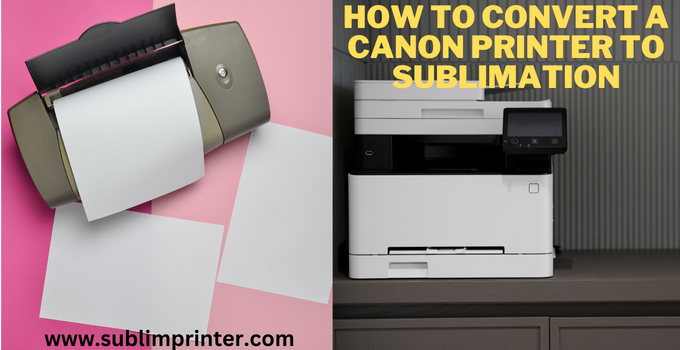Previously, people spent tons on sublimation printers to carry out subliming tasks. Not only were these printers quite expensive, but their maintenance and ink costs were also incredibly high. Therefore, small business owners would find it highly challenging to afford such sublimation printers. Those seeking affordable sublimation methods must try out the Canon printers, as they are affordable and pretty accessible. Check out the following context if you want to know how to convert a canon printer to sublimation.

Therefore, considering these problems, people have transitioned toward custom-made sublimation machines from printers. By converting a printer to sublimation, one can effectively reduce purchase and maintenance costs.
Not all printers can be converted to sublimation. In actuality, a few brands manufacture printers suitable for sublimation. Canon is one of those companies whose printers can easily be converted to sublimation machines.
How to Convert a Canon Printer to Sublimation

Canon printers can easily be converted to sublimation, yet they are susceptible to this conversion procedure. Any mishandling can damage the printer and make it unsuitable for the sublimation process. Therefore, you must implement the conversion steps carefully to make the printer eligible for sublimation successfully.
Contrary to some misconceptions, not all printers can be converted to sublimation. Thus, before acknowledging the procedure, it is crucial to determine which types of printers are suitable for sublimation conversion.
Requirements for Sublimation Conversion
As stated earlier, not every printer can be converted to sublimation. Instead, only that printer will be considered eligible for sublimation compatible with the sublimation ink. If the printer isn’t compatible with the sublimation ink, then it won’t be able to respond to the heating source, and no sublimation will take place.
The sublimation technique transforms the liquid substance (ink) into gases and creates an impression over the substrate. Thanks to this procedure, high-quality colored or monochrome images are created, which are much superior in quality to the ones made by conventional printing techniques.
For the sublimation process, a heating source is also required. With this heating source’s help, the printer can convert the substance into gaseous particles. Thus, if a printer cannot handle extreme heating, it won’t be suitable for sublimation.
Inkjet printers are considered the ideal type of printers for sublimation conversion. Not only do they can survive extreme temperatures, but they are also compatible with almost every type of sublimation ink.
In the Canon range, every inkjet printer without a thermal printer head can be converted to sublimation. Canon mostly has thermal head inkjet printers; that is why, their sublimation potential reduces as compared to other brands like Epson.
Conversion of Brand-New Canon Printers

The sublimation conversion process for newly bought and used printers are quite different. Thus, for better understanding, both procedures will be discussed individually.
Converting a brand-new Canon printer is probably the easiest. You can successfully transform your Canon printer into a sublimating machine within a few steps. The following are a few items to make the Canon printer eligible for sublimation.
- Sublimation Ink Cartridges
- Sublimation Papers/Substrates
- A Heating Source
After setting up the printer, fill its tank with compatible sublimation ink. Then remove the printhead, as it is useless in the sublimation process. Next, you will have to attach the heating source to the printer. Once you are done, start the printer; it will be all set for performing sublimation.
Usually, people make the mistake of using conventional paper sheets or substrates to get sublimation impressions. As a result, they end up getting the paper or substrate damage. That is why buying a good-quality sublimation or substrate is crucial to avoid such consequences.
Conversion of a Used Canon Printer

The conversion of a used Canon printer to sublimation is relatively more complicated than a newly bought printer. The reason is that the storage tanks and printer heads of such printers have already been subjected to printing ink. Therefore, you must remove the ink before prepping the printer for sublimation.
Unlike other machines, the printer must not come in contact with fluids, including water. That is why the ink-removing procedure becomes pretty complex and hassling. To remove the printing ink from the tank, flip the printer into a bucket and let it sit there for a few minutes.
Tilt the printer in different directions to get the ink out. You can even take help from purge fluids to remove the printing ink. You must pour a small quantity of purge liquid into the tank and shake it swiftly. Then flip the tank again to remove the remaining ink.
Once the ink is removed from the printer, switch it on and run it on cleaning mode. This process will ensure thorough printer cleaning. Now that you have cleaned the printer, check the printer head of the machine and analyze if it is working fine.
After ensuring the printer’s functionality, pour the sublimation ink into the tank. Then connect the heat source to the printer to initiate the printer’s sublimation mode.
Which is Better for Sublimation; Printer or Sublimation Device?

The dye sublimation machines are obviously better in terms of quality and functionality than printers. However, it is their cost and maintenance expenditures that downgrade them. You cannot afford a dye sublimation machine if you run a small or home-based business. But buying a printer and converting it to sublimation is always an affordable option.
Thus, in such scenarios where the budget is low, inkjet printers are considered ideal for sublimation tasks. First, their purchase cost is much lower than dye sublimation printers, and second, they require lower maintenance than the latter ones. Though the yield of such printers is low, they prove more economical.
Conclusion: how to convert a canon printer to sublimation

How to convert a canon printer to sublimation might seem a complicated task, but in actuality, it is pretty simple. With the help of good-quality sublimation ink and a viable heat source, the conversion process can be done within a few minutes. But since the sublimation process is quite different from conventional printing, you will need to install a different application software on your computer to access the converted sublimation printer.
